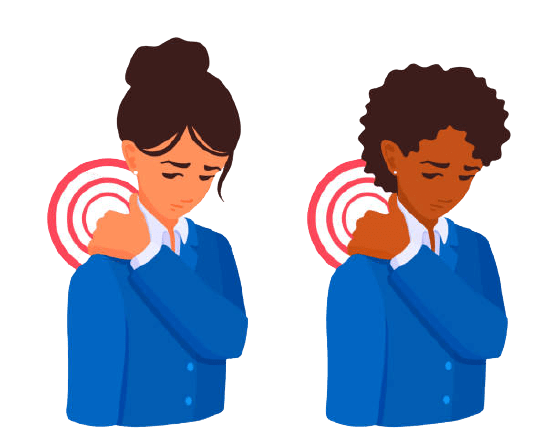Cervical pain treatment online | Online Physiotherapy Clinic
- Affordable and reliable Cervical pain treatment
- Video sessions with expert Physiotherapists/ PTs.
- Specialized physical therapy for Cervical pain, sprain, bursitis, or stiffness
Begin Therapy
Consult online with best Physios
A New model for Wrist Pain treatment
We understand that it’s difficult for most of us to find time for traditional Cervical physical therapy. Physio Mantra brings to you online Cervical pain treatment, where all Cervical exercises and treatments are managed through regular online check-ins & video sessions.
Expert Physical therapists
Physio Mantra members get matched with a professional physiotherapist for one-on-one Cervical pain treatment. They use interactive exercise videos available on our app to treat you.
Continuous Medical Care
Physio Mantra physiotherapists are 100% virtual and provide physical therapy to patients without any time and geographical barriers. Our technology-enabled approach helps manage physical ailments from head to toe.
Personalized Cervical Pain therapy
Physio Mantra provides everyday exercises, home remedies, and regular check-ins for all your Cervical pain physiotherapy needs. We individualize treatment for each person, with problems including Cervical pain, muscle injuries, sprain, bursitis, stiffness, and more.

Best Cervical Pain Clinic, Now In Your Pocket
Our physical therapists or PTs are available in all parts of the world via an easy-to-use mobile application. The use of artificial intelligence, and data science enables the patients to connect with expert physiotherapists and get real-time insights into their Cervical health. Download PhysioMantra App Now

How it works

Signup for our Cervical Treatment Program
Just fill up a 5-minute online form to tell us about your Cervical pain history and treatment expectations.

Meet your PT
We will connect you with a physiotherapist who is available 24/7 to you via call or chat.

Connect to our app
Get Physical Therapy sessions on our app via video calls. Follow exercises suggested by our PT and track your progress in the app.
Meet the best online physical therapist
MantraCare physical therapists treat muscle and joint pain problems through a combination of body exercises, video demonstrations, and a healthy diet. Our treatment experience is a better traditional in-person approach in multiple ways.

Dedicated Physio
You get a personal Physio who customizes the exercise plan based on your comfort and needs

App-guided Exercises
3D animations & voice narrations in our app ensure proper and right guidance

Expert care anywhere, anytime
With over 200+ physios, MantraCare is 100% online – no waiting rooms

Exercise Kit
Complete exercise kit with elastic bands, door anchor, and a phone stand – mailed to you
A Complete Guide About Cervical Pain Physiotherapy
Understanding Cervical Pain
Cervical pain is an incredibly common condition that affects millions of people each year. Cervical pain is a type of upper back and neck pain (because the cervical spine runs along your neck) that can be caused by many different things. It’s important to understand what causes it, how it feels, and how you can treat or prevent it in order to best manage this condition.
It also helps to learn more about the anatomy of your neck and how it relates to cervical pain. This also will help you better understand what types of treatment methods may work best for your particular condition.
It also helps to know what to do when cervical pain flares up. There are many different ways to treat and manage cervical pain, so don’t be afraid to ask your doctor for help. Sometimes all it takes is a little bit of over-the-counter medication and some rest, but other times you may need to seek more treatment options.
Types of Cervical Pain
There are many types of cervical pain, but some of the most common include:
Neck Pain
This is the most common type of cervical pain and can be caused by many different things, such as poor posture, stress, or an injury. It also may be caused by a condition such as arthritis or fibromyalgia.
This type of pain can be mild or severe, and it may spread to the shoulders and arms or even cause headaches. It’s important to seek treatment for this type of pain so that you don’t injure yourself further by ignoring symptoms or not taking care of your neck properly at home.
Neck Stiffness
This is another common type of cervical pain, but it does tend to make people feel more uncomfortable than actual physical pain. This stiffness can occur when a person sleeps on their stomach all night long (which puts excess pressure onto the front part of the spine) or has poor posture while sitting in an office chair all day long (which causes them to slouch down). It tends to ease up after moving around some during waking
Cervical Muscle Pain
This occurs when there is excessive strain placed on the muscles in your neck due to poor posture, stress, an injury, or another cause. It’s important to seek medical attention right away if you experience this type of cervical pain because untreated muscle spasms can lead to serious health later down the road.
Cervical Nerve Pain
This occurs when there is a pinched nerve in your neck, which can make it difficult to move and cause sharp pains as well as numbness or tingling sensations down into your arms (or even hands if severe enough). A pinched nerve could be caused by anything from sleeping with poor posture all night long while on one’s side without proper pillows supporting that head/neck area up properly during rest hours through the day-to-day.
Signs of Cervical Pain
There are many signs of cervical pain, but some of the most common include:
Neck Pain
If you have neck pain, you will likely feel it in the area at the base of your skull and/or between your shoulder blades. The pain may be sharp or dull, and it may get worse when you move your head or neck.
Neck stiffness
This feels like a constant tightness in your neck muscles that doesn’t go away no matter how much you move around. It can make it difficult to turn your head or look up or down.
Headaches
These often occur along with neck pain, and they may be throbbing or pulsing in nature. They may also cause nausea and vomiting.
Shoulder Pain
Pain in your shoulders can be a sign that your neck pain is getting worse. The pain may be sharp or dull, and it may radiate down your arm.
Arm Pain
Pain in your arms can also be a sign of cervical pain. It may be sharp or throbbing, and it may get worse when you move your arm.
Numbness/tingling
This is another common symptom of cervical nerve pain. You may feel numbness or tingling sensations in your fingers, hands, arms, or even chest.
Causes of Cervical Pain
There are many causes of cervical pain. Some of the most common include:
Poor posture
This is one of the leading causes of neck and back problems, as well as headaches! Poor posture can strain muscles in your shoulders, causing them to become tight and painful if left untreated over time.
Stress or anxiety
If you’re experiencing stress at work or home life, it may be due to something physical like an injury but could also stem from emotional issues such as relationship troubles with family members/friends/partners, etc because these types of situations tend to cause lots of tension which then translates into physical pain throughout head areas (i.e., headache) down through shoulder blades all along the spine up into our necks when we don’t take necessary time off for restorative practices.
Sleeping wrong
If you often sleep on your stomach or have poor sleeping habits in general, it can lead to tension and pain in your neck muscles. This is because when you’re asleep, your body should be in a relaxed state, but if you’re constantly putting stress on your neck muscles they will stay tight which then leads to pain the next day.
Injury
An injury such as whiplash from a car accident or contact sports can cause severe cervical pain that may last for weeks or even months.
Medical conditions
There are some medical conditions that can cause cervical pain, such as spinal cord compression, osteoarthritis, rheumatoid arthritis, or cervical spondylosis.
Treatment Options For Cervical Pain
There are many treatment options for cervical pain, including :
Physical Therapy
Physical therapy can help reduce stiffness and pain caused by poor posture or injury. There are many exercises and stretches that can help to relieve tension in your neck muscles. Physical therapy is also useful for improving flexibility in the neck and shoulders.
Medications
Over-the-counter medications such as acetaminophen (Tylenol) are often used to treat cervical pain, but prescription pain relievers may be necessary if the symptoms are severe enough. Anti-inflammatory drugs like ibuprofen can also help relieve inflammation in your neck muscles which then leads t less tension/pain over time when taken regularly!
Chiropractic care
A chiropractor may use manual manipulation techniques that can provide immediate relief from neck and back problems caused by stress on these areas of our bodies due to daily activities such as sitting at work all day long without breaks or stretching exercises while we’re not taking care of our physical, emotional and spiritual health.
Surgery
In some cases, surgery may be necessary to correct a problem such as spinal cord compression or nerve damage. Sometimes cervical fusion surgery is recommended to relieve pain and improve function.
Physiotherapy For Cervical Pain
Physiotherapy for cervical pain is one of the most common and effective treatment methods. Physios will perform a thorough assessment to determine the root cause of your cervical pain, and then create a treatment plan tailored specifically for you. This may include manual therapy such as massage or mobilization, exercises and stretches, posture correction advice, and/or use of heat or ice.
It also includes strengthening exercises that target weak muscles in the neck; these are usually done three times per week. It’s important to note that physiotherapy can take up to six weeks before you see any improvement (if at all) so don’t give up! Keep working hard on those stretches and strengthening moves!
Types of Physiotherapy For Cervical Pain
There are many types of physiotherapy for cervical pain, so it’s important to find the right one for you. Some of the most common physiotherapy treatments include:
Manual therapy
This is a type of hands-on therapy that involves massaging and manipulating the muscles and joints to help relieve tension and pain. It can be very effective in relieving symptoms quickly. Sometimes it’s combined with other treatments such as exercises or stretches.
Exercise therapy
This is a type of physiotherapy that involves doing specific exercises and stretches to help relieve tension and pain in the neck. It can be very effective in helping to improve flexibility and strength in the neck muscles.
Posture correction
Many people suffer from poor posture, which can lead to tension and pain in the neck. Physiotherapists can give you advice on how to correct your posture, which can help to reduce symptoms.
Heat or ice
Physios often use heat or ice as part of treatment for cervical pain. Heat may help to relax tight muscles, while ice can help reduce inflammation and swelling. It also helps to numb the area and provide pain relief.
TENS
Transcutaneous electrical nerve stimulation (TENS) is a type of therapy that uses low-voltage electricity to help relieve pain. It’s often used for chronic neck pain and can be very effective in providing relief from symptoms.
Massage
Massage is a popular treatment for cervical pain and can be very effective in relieving tension and stress in the muscles. It’s usually combined with other treatments such as exercises or stretches.
Benefits of Physiotherapy For Cervical Pain
There are many benefits of physiotherapy for cervical pain. Some of the most common benefits include:
Improves Neck Movement
Physiotherapy can help to improve your range of motion in the neck and shoulder area. This means you’ll be able to move more freely without worrying about pain or stiffness.
Reduces Tension and Stress on Joints
Physiotherapy helps reduce tension and stress on joints, which can lead t better posture over time as well! It also helps relieve muscle spasms that may have been caused by poor posture. Physios will work with you to develop a treatment plan for improving mobility so that it becomes easier each day which leads back towards normalcy sooner rather than later after an injury or surgery occurs during the recovery process- these are important things to take note of when dealing with any sort of pain because it’s imperative not just physically but mentally too.
Helps To Maintain Weight
Physiotherapy can help you lose or maintain weight, which is important for your overall health. Weight loss can reduce strain on the joints and muscles in the neck area (which often leads t better posture over time as well!). Physios will work with you to develop an exercise program tailored specifically towards achieving these results.
Reduces Pain and Inflammation
Physiotherapy can help reduce pain and inflammation in the neck area. This can help you feel better overall and make it easier to do everyday activities without feeling overwhelmed by pain.
Improves Strength and Flexibility
Physiotherapy can also help improve strength and flexibility in the neck muscles. This can help you move more freely without worrying about pain or stiffness.
Helps Reduce Stress Levels
Finally, physiotherapy can help reduce stress levels. This is important for your overall health and well-being. When you’re stressed, it often leads to tension and pain in the neck area. Physiotherapy can help relieve this tension and stress, which will make it easier for you to do everyday activities without feeling overwhelmed by pain.
10,000+ Happy Cervical Pain patients from the world

“Those were the difficult days of my life when I was a teacher at one of the Sr. Sec. schools in Nigeria. I had to check a lot of notebooks by keeping my neck downwards. I started developing cervical pain. One of my colleagues then told me about Mantra Care where I can get online physiotherapy. I am so thankful to the physician that guided me about the exercise routine so that I can recover fast.”
Kamya, 3 Months at MantraCare
Best physiotherapist from across the world





We treat nearly all muscle and joint issues
Not all physical or muscle problems are the same. Different types of problems require different treatments. At MantraCare, 200+ physical therapist the world cover a range of specialties to meet your needs be it back pain, shoulder pain, or sports injury:
Frequently Asked Questions
Everyone responds differently to physiotherapy, so there is no one answer to this question. However, you should start to see results within a few weeks of starting treatment.
No, physiotherapy is not usually painful. You may experience some discomfort during exercises or stretches, but this should not be excessive. If you experience any pain that is outside of what is normal, stop the treatment and speak with your physio.
Yes, many types of physiotherapy can be done at home. Your physio will give you a list of exercises that you can perform on your own. If you have any questions about how to do these exercises properly, ask them before leaving their office so that they are clear as well!
Everyone responds differently to treatment, and there is no one answer to this question. However, most people begin seeing results after two or three weeks of starting therapy. If it has been longer than four weeks since the start of treatment without improvement then speak with your physio about alternative options.
Physio can help with cervical pain. Many people find that they get relief after a few weeks of treatment. Some research shows that up to 80% of patients experience at least some improvement from their symptoms if not complete resolution.











